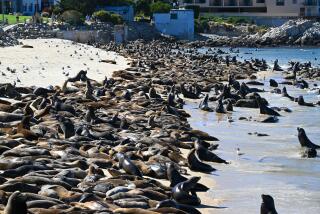It was once known as Rattlesnake Island,...
- Share via
It was once known as Rattlesnake Island, a narrow sand pit in the midst of what is now the Los Angeles Harbor that got its name from the reptiles that were swept down the Los Angeles River by heavy spring rains. But at the turn of the century, the wealthy knew it as Brighton Beach, a fashionable resort on the southern end of Terminal Island.
The upper-class playground--at the time considered second only to Coronado Island in San Diego County--was on present-day Seaside Avenue between Ferry Street and Navy Way in East San Pedro. A hotel, restaurant, bar and more than 200 picturesque cottages dotted the shore. Electric lights were strung across the boardwalk. At low tide, the beach was a quarter-mile wide, and bathers could wade far out into the water.
Terminal Island was connected to Long Beach by a railroad and a pontoon bridge, now by the Gerald Desmond Bridge. For 5 cents each way, travelers could cross the 500-foot-wide channel on the ferry Blanche, which was launched from San Pedro at the 5th Street Landing. However, schoolboys saved the fare by swimming across the channel, leaving their clothes with one youth who would make the crossing on the ferry. Most of the boys worked on the island’s first fish cannery, removing sardine heads.
By 1901, Brighton Beach had become the rallying point for the finest yachts along the coast. Their wealthy owners built a clubhouse and organized Southern California’s first recreational boating group. It was called the South Coast Yacht Club and was the forerunner of the Los Angeles Yacht Club. The first official yacht race was held May 30, 1902, from the Brighton Beach wharf to the buoy off San Pedro’s Point Fermin.
Brighton’s place in the sun came to an end about 1916 when the Los Angeles Harbor undertook a major dredging project, adding landfill that pushed the shoreline almost a mile from its original location. As the beach shrunk and more canneries were built, the leisure crowd sold or rented their houses to a new group of working-class residents--Japanese immigrants.
By 1941, more than 3,000 Japanese-Americans were living in the area. With World War II under way, federal officials placed Terminal Island under an unusual order--no one was allowed to enter or leave without being checked by the military. On Feb. 28, 1942, the island was evacuated and members of its sizable Japanese-American community were sent to relocation camps.
History might remember this portion of Terminal Island best as the birthplace of America’s fish canning industry. At its height, it had 18 canneries and provided about 17,000 jobs. Only two remain: Pan Pacific Fisheries and Heinz Pet Products. Some buildings have been torn down while others remain vacant.
Today, it is a leading port of entry for imported automobiles. Where the Japanese-Americans of Fish Harbor once lived, Japanese-built cars stand in vast storage yards, awaiting transportation to dealers.
More to Read
Sign up for Essential California
The most important California stories and recommendations in your inbox every morning.
You may occasionally receive promotional content from the Los Angeles Times.










